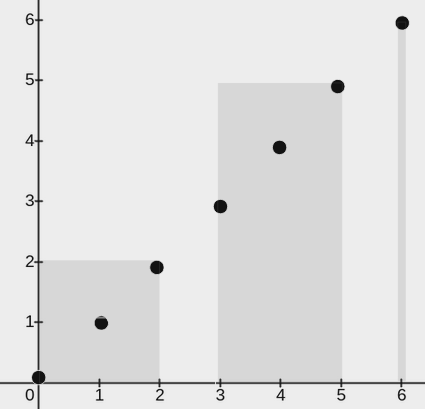
g3101_3200.s3111_minimum_rectangles_to_cover_points.readme.md Maven / Gradle / Ivy
Go to download
Show more of this group Show more artifacts with this name
Show all versions of leetcode-in-java Show documentation
Show all versions of leetcode-in-java Show documentation
Java-based LeetCode algorithm problem solutions, regularly updated
The newest version!
3111\. Minimum Rectangles to Cover Points
Medium
You are given a 2D integer array `points`, where points[i] = [xi, yi]. You are also given an integer `w`. Your task is to **cover** **all** the given points with rectangles.
Each rectangle has its lower end at some point (x1, 0) and its upper end at some point (x2, y2), where x1 <= x2, y2 >= 0, and the condition x2 - x1 <= w **must** be satisfied for each rectangle.
A point is considered covered by a rectangle if it lies within or on the boundary of the rectangle.
Return an integer denoting the **minimum** number of rectangles needed so that each point is covered by **at least one** rectangle_._
**Note:** A point may be covered by more than one rectangle.
**Example 1:**

**Input:** points = [[2,1],[1,0],[1,4],[1,8],[3,5],[4,6]], w = 1
**Output:** 2
**Explanation:**
The image above shows one possible placement of rectangles to cover the points:
* A rectangle with a lower end at `(1, 0)` and its upper end at `(2, 8)`
* A rectangle with a lower end at `(3, 0)` and its upper end at `(4, 8)`
**Example 2:**

**Input:** points = [[0,0],[1,1],[2,2],[3,3],[4,4],[5,5],[6,6]], w = 2
**Output:** 3
**Explanation:**
The image above shows one possible placement of rectangles to cover the points:
* A rectangle with a lower end at `(0, 0)` and its upper end at `(2, 2)`
* A rectangle with a lower end at `(3, 0)` and its upper end at `(5, 5)`
* A rectangle with a lower end at `(6, 0)` and its upper end at `(6, 6)`
**Example 3:**

**Input:** points = [[2,3],[1,2]], w = 0
**Output:** 2
**Explanation:**
The image above shows one possible placement of rectangles to cover the points:
* A rectangle with a lower end at `(1, 0)` and its upper end at `(1, 2)`
* A rectangle with a lower end at `(2, 0)` and its upper end at `(2, 3)`
**Constraints:**
* 1 <= points.length <= 105
* `points[i].length == 2`
* 0 <= xi == points[i][0] <= 109
* 0 <= yi == points[i][1] <= 109
* 0 <= w <= 109
* All pairs (xi, yi) are distinct.© 2015 - 2024 Weber Informatics LLC | Privacy Policy